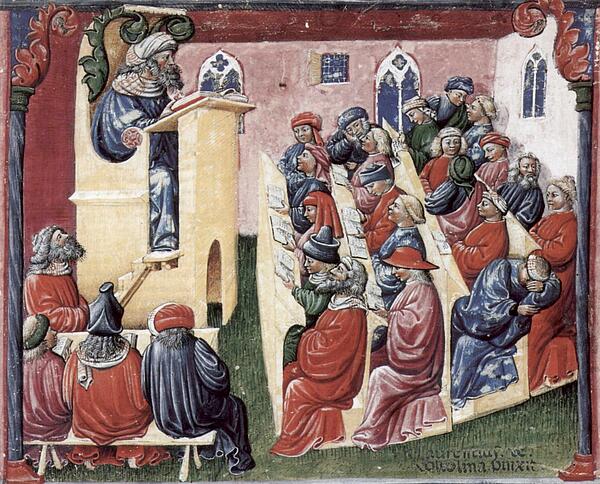Medieval Students
Th life of a medieval student wasn't easy. Students would have to begin studying at the age od 14 or 15, with lectures beginning at 5 or 6am. Medieval universities offered very different education from that we know today, usually based around Theology or the arts.
Oxford and Cambridge are among the oldest universities in the world. During the Middle Ages, the students at these institutions were expected to continue and build on research, but they were also major centres for student learning and well respected by other learning centres in the English speaking world.
Historians have a large amount of information about students at Oxford and Cambridge, mainly due to the fact that the universities have worked hard to preserve their documents over the many hundreds of years they have been providing education. It is made clear from these documents that all students at both institutions were taught by men from the church, with Theology one of the most common subjects. Due to the heavy power and influence of religion in Medieval England, it was also one of the most prestigious subjects that could be studied.
Documents have also revealed that there were many incidents of disorder in early learning institutions, with one decribing how "a student who attacked his professor with a sword" caused great damage to the lecture room - and to the lecturer. Clashes were also frequent among students, usually following a debate in the classroom. Additionally, fights appear to have been common in the streets of both cities, usually occuring between students and the people living in the towns.
The relationship between students and the townspeople were so strained in Oxford that Walter de Merton, founder of Merton college in Oxford, actually founded another college in Cambridge as he feared for his scholars' safety.

Class differences spilled into the learning environment, according to historial documents, and medieval students were seperated by their class and wealth. Historian Charles Homer Haskins revealed that those attending Oxford and Cambridge with a wealthy background would eat "well peppered pies of pork, chicken and eels... pigeons, geese and other fowl roasted on a spit", while poor students were forced to eat tripe.
Records also reveal that students with wealthy parents could have had the opportunity to buy their way to a degree. However, parents would often insist that their sons at least sit their exams, perhaps in a bid to ensure their investment had at least provided him with some knowledge.
While records kept by both universities are well-preserved, there are no exact figures for the number of students who attended either institution during the Middle Ages. However, there is a document in existence that dates back to 1298 and states there were 3,000 'clerks' (students) at Oxford who fought with townsfolk. Despite this record, historians believe this number to be an exaggeration.
Each college at both universities had statutes that would ensure they abided by strict rules of conduct. If students broke these statutes, they could go to prison or even be excommunicated. However, there was no corporal punishment for students during the Middle Ages. This did eventually change, and by the end of the 15th Century students could be beaten for selling his books without permission or breaking other similar rules.
Records show that Oxford University provided no meals for its students before 10am during the Middle Ages, with the time between 6am and 10am dedicated to lectures instead. Breakfast would then last for one hour before lectures began once more at 12 noon, with a finish time of around 5pm.
At both universities, the evenings were dedicated to the students own hobbies and pastimes. The colleges commonly allowed gambling, chess playing and the playing of musical instruments. However, all statutes forbade jousting, huntign and hawking, as all of these hobbies were seen as signs of wealth and potentially divisive occupations.
There were very few holidays given to medieval students, but they were allowed to use church holidays as rest days. Oxford in particular celebrated two church days for St. John to Baptist and for St. Peter. Sundays were used as days of worship or for additional lectures.
Medieval students lived in sparse accomodation, with no college at Oxford allowing fires in rooms. This also included lecture rooms, which were often cold. The only warmth students could access during winters was via straw, which would be spread across the floor to provide insulation. According to historical records, no college covered their windows with glass until the year 1300, meaning students were subjected to all forms of weather.
See also:
MLA Citation/Reference
"Medieval Students". HistoryLearning.com. 2026. Web.
